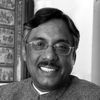The year was 1960. KP Singh, now chairman emeritus of the real estate giant, DLF, was then an officer of the Indian Army. He was travelling from Secunderabad to Delhi. At the station, there was a mad rush to get into the train. KP, sitting in his first-class coupe, saw a thin, tall, bare-footed, bearded man, with a tin box on his head, desperately trying to get into the train. As a last resort, he pleaded with KP to let him in, and KP agreed. That man was MF Husain.
That chance meeting led to a life-long friendship. Husain was employed by DLF as its art director for a paltry amount of some ₹3,000, but over time his paintings rose to skyrocketing prices. Many decades later, when KP met Husain in Dubai, where he was in self-imposed exile, he had a fleet of luxury cars and a museum to his name. At the home of Lord Gulam Noon, in London, I saw a portrait made by Husain in the 1950s of Noon’s father in Mumbai. He had charged ₹15 for the work. In March 2023, one of Husain’s paintings sold at an auction for a whopping ₹24 crore!
So, is art a good investment? It is true that some painters — SH Raza, VS Gaitonde, Husain, Rameshwar Broota, and Ram Kumar — to name just a few, sell at prices that are astronomical compared to what they were sold for years ago. Aman Nath, the founder of Neemrana Hotels, bought a Tyeb Mehta for ₹2,700 in 1979. In 2006, he sold it for ₹3.5 crore and bought a house in Nizamuddin East in Delhi. Today, that painting is priced at ₹17 crore and featured on the cover of Sotheby’s catalogue.
Investment in Indian art has gone up by 250% in the last decade. Last year alone saw a 9% rise in turnover and a 6% increase in the number of works sold. This was facilitated by as many as 103 online auctions in 2022, held by internationally reputed firms like Sotheby’s and Saffron Art. The annual India Art Fair, and the Kochi-Muziris Biennale, have soared in popularity. Today, the turnover of Indian art has reached $144.3 million. Last year, the late Amrita Sher-Gil’s work, The Storyteller fetched ₹61.8 crore, the highest for an Indian painter.
Yet, it is sobering to note that the Indian art market accounts for only 0.5% globally. The United States has 43% of the cake, and, significantly, China 27%. For a three trillion economy like ours, the art market should be at least six times more. In a country of 1.4 billion, which has the third largest number of billionaires in the world, there are less than 500 serious art buyers.
Often, we don’t know the worth of our own emerging artists. One of the most talented among them is Manish Pushkale. Last year, the famous Musee Guimet in Paris selected his work for display, and it was visited by over 50,000 visitors. It is now moving to the Asiatic Museum of Art in Nice. How many Indians know of this success story?
Manish’s life reads like a dramatic movie script. He arrived in Delhi penniless in 1996 and slept for days on the platform at Nizamuddin railway station. His first buyer was the renowned artist, Sakti Burman, who paid ₹11,000. The next icon to spot his talent was Raza, who also became his guru. Famous artist Manjit Bawa bought one of his works for ₹13,000, sold it to an art collector for ₹1 lakh, and in an exceptionally gracious gesture, gave the ₹87,000 he earned back to Manish. Last year, one of Manish’s paintings fetched ₹67 lakh. He now no longer lives in Shakarpur, where his landlords were a generous group of eunuchs, but has his own twin-floor home in Hauz Khas.
Indian art is yet to get its due global recognition. That will happen when our artists shun mimicry, work with the originality that has been the hallmark of our ancient civilisation, and have far more patrons, if only for investment.
Pavan K Varma is author, diplomat, and former Member of Parliament (Rajya Sabha). The views expressed are personal
Just Like That | Why Indian art is a blip on the big global canvas
 26
26
 1
07.04.2024
1
07.04.2024
The year was 1960. KP Singh, now chairman emeritus of the real estate giant, DLF, was then an officer of the Indian Army. He was travelling from Secunderabad to Delhi. At the station, there was a mad rush to get into the train. KP, sitting in his first-class coupe, saw a thin, tall, bare-footed, bearded man, with a tin box on his head, desperately trying to get into the train. As a last resort, he pleaded with KP to let him in, and KP agreed. That man was MF Husain.
That chance meeting led to a life-long friendship. Husain was employed by DLF as its art director for a paltry amount of some ₹3,000, but over time his paintings rose to skyrocketing prices. Many decades later, when KP met Husain in Dubai, where he was in self-imposed exile, he had a fleet of luxury cars and a museum to his name. At the home of Lord Gulam Noon, in London, I saw a portrait made by Husain in the 1950s of Noon’s father in Mumbai. He had charged ₹15 for the work. In March 2023,........
© hindustantimes
 visit website
visit website






















 Toi Staff
Toi Staff Gideon Levy
Gideon Levy Belen Fernandez
Belen Fernandez Rami G Khouri
Rami G Khouri Mort Laitner
Mort Laitner Donald Low
Donald Low Ali Fathollah-Nejad
Ali Fathollah-Nejad Nikkei Editorial
Nikkei Editorial
